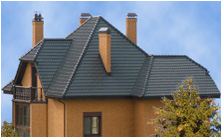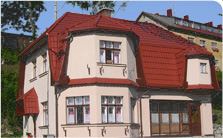Operated roof. Attic Decoration
How to make the roof exploited?
Serious problem of large cities - the lack of available land and its cost. Overcrowding and high density development leads to huge traffic jams, lack of available parking and walking areas, an increase in gas concentration, deterioration of the already not very happy the environmental situation in the city. And if the estate can be directly planned highways and municipal parking above ground, in the older parts of it can be done. In addition, in recent years has been popularly construction of elite residential complexes of closed with a built and attached garages, entrance to which is carried out directly from the building and the roof is used as a yard area (travel, playgrounds, green space areas).
We should not forget about the prospective use as a recreational zone of the existing soft roofs (especially in the old part of town). The area of roof is huge and the costs of reconstruction are not comparable with the organization of such zones on earth. Operated by the flat roofs are gaining in popularity.
So, operated roof - unusual, but a wise and prudent approach to the dwelling house, office building, villa. This is an additional useful area of the building, which can accommodate a solarium, conservatory, a viewing platform, parking or even a tennis court.
Operated roof can be classified by type according to their functional purpose: coating with a limited ability to walk (gravel backfill), covering walking, "green" roof, covering, suitable for traffic and parking devices. Very often, these types of coatings can be combined, for example, walking paths can be combined with areas of gravel backfill, and landscaped areas, etc. Sketch the most characteristic of them.
Roof garden
On the concept of 'winter garden', not so long ago appeared in the domestic construction, added one more definition - "a garden on the roof." Greening roofs are very popular in western countries. There were even new construction technologies aimed at developing new types of gardening. Roof gardens - is a kind of mini-parks, which allow you to relax in nature without leaving the building. There are two versions of the device gardens on roofs: in new buildings and old, are often not trained for that. In the second case, the problem becomes more complicated, because when the device garden on the roof to face the following problems: high levels of humidity and significant additional load, such as from soil and from the plants themselves. If necessary to facilitate the construction of the soil is replaced much more easily (though expensive) artificial substrate, which absorbs and stores moisture.
Device such roofs became possible after the launch of high hydro-and thermal insulation materials of new generation, as well as materials that provide reliable protivokornevuyu protection. The problem protivokornevoy protection of roofs - one of the most pressing. Quite a long time it tried to solve with protective cement-sand screed or solid asphalting. But as you know, the roots break even granite monolith. More than 20 years ago it was discovered an interesting phenomenon: the roots of low plants in contact with cloth made of nonwoven polypropylene begin to spread across the surface without violating the very fabric. From this it was concluded that this cloth has protivokornevymi properties. The exact scientific explanation for this phenomenon, but here for over 20 years is the canvas used in the roofs of exploited as a filter and protivokornevoy protection and shows excellent results. One species represented in our market protivokornevogo geotextile fabrics is TYPAR manufacturing concern Du Pont.
The materials for the device "green roofs" are special requirements for quality and longevity, resistance to microorganisms, environmental friendliness and durability. In this case the roof does not need regular maintenance.
For reliable waterproofing used polymeric roofing membrane based on modified bitumen in connection with their highest climatic, chemical and biological stability and durability. On top of the roof membrane is laid a layer of protective geotextile. Function more protivokornevoy protection and water drainage carries drainage material. With this purpose high-rolling materials based on high-pressure polyethylene with subulate appendages. In turn, the filter layer is designed to prevent clogging of the drainage of the soil particles, plant.
The thickness of the topsoil with vegetation of the selected type of "green roofs" should meet the requirements of the bearing capacity of foundation soils and the requirements for the landing of the selected type of vegetation.
The boundaries between the lawn, running tracks are made of curbs, concrete corner, impregnated timber, etc.
Perhaps the extensive landscaping of the roof - drought-resistant, self-replicating plants (grasses, mosses) as well as intensive gardening - shrubs and trees, allows to create on top of parkland.
Inversion roofing
When the device operated roof is necessary to consider that, apart from the requirements for conventional roof (protection of the interior of the building from external influences), its design must withstand heavy loads, usually unevenly distributed over the surface. The organization operated a flat roof is a complex multifactorial problem, one solution is - a device of stripping the roof.
Inversion of the roof have been successfully operated in Western Europe for over 30 years. Device such roofs became possible after the launch of high hydro-and thermal insulation materials of new generation.
As is known, the traditional design of the roof does not have enough stiffness and can not be used as exploited, as in this case, the waterproofing layer is exposed to strong mechanical stress. Principle of inversion of the roof is that the insulation is placed over a waterproofing layer and thus protects it from adverse effects (climatic and mechanical).
The most common response to the inversion of the roof the following: waterproofing layer (usually rolled materials based on bitumen - evroruberoid) layer of rigid insulation, geotextiles, protective top layer. The upper layer stripping of the roof, usually used backfilling of stone materials (gravel, pebble), paving slabs or ground layer with established plants. As hard heater most efficient use of extruded polystyrene foam, closed cell structure which, together with high mechanical strength and water resistance provides an extremely low water absorption materials. Inversion of the roof design improves the life of the waterproofing layer due to the fact that it operates all year round at a constant temperature close to the temperature inside the building and not exposed to the damaging effects of UV light and mechanical stress. In addition, the structure of the roof increases the fire safety of buildings.
When using the roof surface for the passage of transport (parking device) is recommended inversion option, since under such extreme stresses protection of water-insulating mat of particular importance. Moreover, often parked on the roofs are not just for cars but also for freight transport. Between insulation boards and the road surface (monolithic or precast concrete) on top of the filter carpet layer, there should be a layer of gravel backfill. When the device monolithic concrete pavement should be laid before concreting the separation layer of polyethylene to prevent water slide (cement "milk") in the gravel layer. Selection of parameters of concrete cover must be made on the basis of static calculations.
When the device of the inversion of the coating to a heater higher demands than those that are set for a layer of insulation, which is located in the thickness of conventional roofing pie. It is known that the penetration of water vapor in the insulation and moisture, repeated cycles of freezing and thawing, "eventually lead to the loss of insulating properties and fracture of the material. Therefore, as a heat insulation device inverted roofing materials to be applied, have almost zero water absorption, as well as high strength and low thermal conductivity. These materials must be securely protect waterproofing from the sharp temperature fluctuations and other adverse mechanical and environmental impacts. All these requirements are met by the brand extruded polystyrene Penoplex "used as an alternative to such materials as« Foamglas »(foamed glass) and« Stirofoam »(extruded polystyrene). Along with zero capillarity and low water absorption extruded polystyrene have an unusually high compressive strength, consistently stable insulating characteristics. He is hardy, durable, chemically resistant and nepodverzhen rotting.
High demands are made and the waterproofing layers in inverted roofs. These materials include the best representatives of polymer-bitumen and polymeric materials (such as Polyglass and Izolit).
And finally, one more important note: when performing such important tasks as the inversion top, a key success factor is the qualifications of the artist. After all, if you use high-quality, durable, albeit more expensive on a one-time investment, the materials in 95% of cases the cause of the problems are poorly executed work. Accordingly, in order to fully realize the benefits of good material, you need a technically competent, responsible and well-trained, experienced contractor.
Source: BudMajster. 2002. № 7. C.14-15





